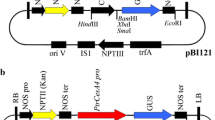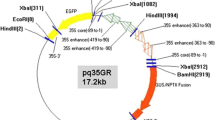Abstract
A biolistic protocol for the stable genetic transformation of the hardwood tree Paulownia elongata was developed. Leaf explants were bombarded using the PDS-1000/He system with plasmid pBI121. The introduced DNA contained the β-glucuronidase (GUS) reporter gene and neomycin phosphotransferase (nptII) as a selection marker. Transformed calli were induced and selected on medium supplemented with 50 mg L−1 kanamycin, and transgenic plants were regenerated through indirect organogenesis. Complete plants were successfully transferred to soil and established under greenhouse conditions. Different helium pressures and explant positions were used and the transformation frequency was calculated. Optimal conditions for genetic transformation were bombardment of the abaxial leaf surface at a pressure of 450 psi. The integration of the transgenes in the plant genome and their stable expression was demonstrated by fluorometric GUS assay, determination of NPTII activity and PCR analysis. This method allows the production of transgenic trees of P. elongata in a relatively short time.




Similar content being viewed by others
References
Ates S, Ni Y, Akgul M, Tozluoglu A (2008) Characterization and evaluation of Paulownia elongota as a raw material for paper production. Afr J Biotechnol 7(22):4153–4158
Bergmann BA (1998) Propagation method influences first year field survival and growth of Paulownia. New Forest 16:251–264
Bergmann BA, Lin X, Whetten R (1999) Susceptibility of Paulownia elongata to Agrobacterium and production of transgenic calli and hairy roots by in vitro inoculation. Plant Cell Tissue Organ Cult 55:45–51
Birnboim HC, Doly J (1979) A rapid alkaline extraction procedure for screening recombinant plasmid DNA. Nucleic Acids Res 7:1513
Bock R (2004) Studying RNA editing in transgenic chloroplasts of higher plants. In: Gott JM (ed) RNA inference, editing, and modification: methods and protocols. Methods in molecular biology, vol 265. Humana Press, Totowa, pp 345–356
Cabrera-Ponce JL, López L, Assad-García N, Medina-Arevalo C, Bailey AM, Herrera-Estrella L (1997) An efficient particle bombardment system for de genetic transformation of asparagus (Asparagus officinalis L.). Plant Cell Rep 16:255–260
Castellanos-Hernández OA, Rodríguez-Sahagún A, Rodríguez-Domínguez JM, Rodríguez-Garay B (2006) Organogénesis indirecta y enraizamiento in vitro de Paulownia elongata. e-Gnosis 4(15):1–12
Du T, Wang Y, Hu QX, Chen J, Liu S, Huang WJ, Lin ML (2005) Transgenic paulownia expressing shiva-1 gene has increased resistance to Paulownia Witches’ Broom disease. J Integr Plant Biol 47(12):1500–1506
Hunold R, Bronner R, Hahne G (1994) Early events in microprojectile bombardment: cell viability and particle location. Plant J 5(4):593–604
Ipekci Z, Gozukirmizi N (2004) Direct somatic embryogenesis and synthetic seed production from Paulownia elongata. Plant Cell Rep 22:16–24
Ipekci Z, Gozukirmizi N (2005) Indirect somatic embryogenesis and plant regeneration from leaf and internode explants of Paulownia elongata. Plant Cell Tissue Organ Cult 79:341–345
Ipekci Z, Altinkut A, Kazan K, Bajrovic K, Gozukirmizi N (2001) High frequency plant regeneration from nodal explants of Paulownia elongata. Plant Biol 3:113–115
Jefferson RA, Kavanagh TA, Bevan MW (1987) GUS fusions: β-glucuronidase as a sensitive and versatile gene fusion marker in higher plants. EMBO J 6:3901–3907
Melhuish JH, Gentry CE, Beckjord PR (1990) Paulownia tomentosa seedling growth at different levels of pH, nitrogen and phosphorus. J Environ Hortic 8:205–207
Mitsui M, Murohashi Y, Asano Y, Masada M, Kodama H (2003) Transient assay for in vivo splicing in tobacco leaf cells by particle bombardment. Plant Mol Biol Rep 21:21–30
Mohri T, Shinohara K (1996) A biolistic approach for the transfer and expression of a luciferase gene in Paulownia (Paulownia fortunei). J For Res 1:65–66
Mohri T, Igasaki T, Shinohara K (2003) Agrobacterium-mediated transformation of Paulownia (Paulownia fortunei). Plant Biotechnol 20:87–91
Murashige T, Skoog F (1962) A revised medium for rapid growth and bioassays with tobacco tissue cultures. Physiol Plant 15:473–497
Newman SM, Bennett K, Wu Y (1998) Performance of maize, beans and ginger as intercrops in Paulownia plantations in China. Agroforestry Syst 39:23–30
Poupin MJ, Arce-Johnson P (2005) Transgenic trees for a new era. In Vitro Cell Dev Biol Plant 41:91–101
Prakash AP, Kumar PP (2002) PkMADS1 is a novel MADS box gene regulating adventitious shoot induction and vegetative shoot development in Paulownia kawakamii. Plant J 29(2):141–151
Roy P, Sahasradbudhe N (1990) A sensitive and simple paper chromatographic procedure for detecting neomycin phosphotransferase II (NPTII) gene expression. Plant Mol Biol 14(5):873–876
Russell JA, Roy MK, Sanford JC (1992) Physical trauma and tungsten toxicity reduce the efficiency of biolistic transformation. Plant Physiol 98:1050–1056
Sanford JC, Smith FD, Russell JA (1993) Optimizing the biolistic process for different biological applications. Meth Enzymol 217:483–509
Schneider H (1981) Plant anatomy and general botany. In: Clark G (ed) Staining procedures. Williams and Wilkins, Baltimore, pp 315–331
Shure M, Wessler S, Fedoroff N (1983) Molecular identification and isolation of the Waxy locus in maize. Cell 35:225–233
Tomes DT, Ross MC, Songstad DD (1995) Direct DNA transfer into intact plant cell via microprojectile bombardment. In: Gamborg OL, Phillips GC (eds) Plant cell tissue and organ culture: fundamental methods. Springer-Verlag, Berlin, pp 197–213
Wang Q, Shogren JF (1992) Characteristics of the crop-Paulownia system in China. Agric Ecosyst Environ 39:145–152
Zhang H (2000) Paulownia breeding, cultivation, utilization and extension in China. APAFRI, Kuala Lumpur
Zhu ZH, Chao CJ, Lu XY, Xiong YG (1986) Paulownia in China: cultivation and utilization. Asian Network for Bio Sci & Inter Devel Res Centre, Canada, 65 pp
Acknowledgments
OACH and ARS wish to thank CONACYT (Consejo Nacional de Ciencia y Tecnologia) for PhD fellowships, Authors are grateful to Aurora Verver y Vargas for her invaluable help with the histological analysis.
Author information
Authors and Affiliations
Corresponding author
Rights and permissions
About this article
Cite this article
Castellanos-Hernández, O.A., Rodríguez-Sahagún, A., Acevedo-Hernández, G.J. et al. Transgenic Paulownia elongata S. Y. Hu plants using biolistic-mediated transformation. Plant Cell Tiss Organ Cult 99, 175–181 (2009). https://doi.org/10.1007/s11240-009-9590-2
Received:
Accepted:
Published:
Issue Date:
DOI: https://doi.org/10.1007/s11240-009-9590-2




